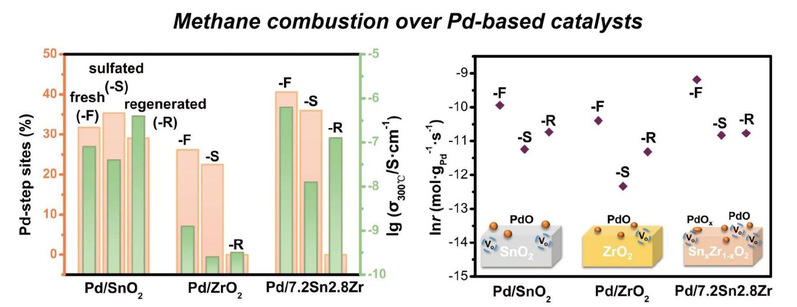Though natural gas, a cleaner energy source than coal and oil, is used as a fuel in such fields as gas-fired power plants and natural gas powered automobiles, its utilization releases incompletely burned methane, which has a negative impact on the environment. Catalytic combustion technology can effectively purify low-concentration methane. Palladium(Pd)-based catalysts are highly active for methane combustion but they are easily agglomerated and sintered at high temperatures and poisoned and deactivated under water-vapour-containing, SO2-containing and other atmospheres. To solve this problem, the research team has carried out research on the design of efficient and stable Pd-based catalysts.
Recently, great progress has been made on the basis of the previous research (ACS Appl. Mater. Interfaces, 2022, 14, 16233-16244;J. Cleaner Prod., 2023, 385: 135744). The research results, entitled “Key factors for methane combustion over Pd-based catalysts revealed by enhanced and depressed catalytic performance”, has been published in Applied Catalysis B: Environmental. The supported palladium catalysts prepared from tin-rich and zirconium-rich tin-zirconium binary oxides were found to differ significantly in the low-temperature activity and water resistance. When the supported palladium catalysts were prepared with a specific tin-zirconium mass ratio, the formation of tin-zirconium solid solutions generated more oxygen vacancies and induced high lattice oxygen activity of PdO species, with excellent low-temperature activity, thermal stability, and water resistance. However, after the zirconium-containing catalysts were sulfated and regenerated, generated sulfates caused the decrease in the oxygen vacancies, thereby inhibiting oxygen exchange between PdO and lattice oxygen and gas-phase oxygen and making the palladium particles prone to sintering. In contrast, the tin-containing catalysts had weak interaction with sulfur and good regeneration performance. Through tuning the composition of the catalysts, efficient and stable Pd-based catalysts with high oxygen mobility and high sulfur resistance were obtained.
The College of Chemistry and Materials Science of FNU is the first completion unit of this paper, with Lin Jia, a teacher on the team, as the first author and Prof. Zheng Ying as the corresponding author. The work was funded by the National Natural Science Foundation of China (NSFC) and the National Foundation of China (NFC) Youth Program, and supported by the testing platform of the National Engineering Research Centre for Chemical Fertilizer Catalysts of Fuzhou University.
Paper link: https://doi.org/10.1016/j.apcatb.2023.123283

(Translated by Wang Ye/ Reviewed by Xie Xiujuan)
